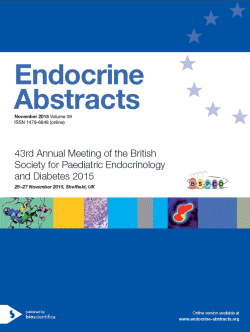
43rd Meeting of the British Society for Paediatric Endocrinology and Diabetes
e-Posters
Pituitary and growth
ea0039ep101 | Pituitary and growth | BSPED2015
Case series evaluating phenotypical and radiological signs of patients with SHOX mutation
Childs Alexandra , Ferguson Jane , Burren Christine , Crowne Elizabeth , Moudiotis Christopher
ea0039ep102 | Pituitary and growth | BSPED2015
Final adult height and childhood growth trajectories in a cohort of preterm infants
Ferguson Elspeth , Wales Jerry , Gibson Alan , Carney Sally , Wright Annie , Wright Neil
ea0039ep103 | Pituitary and growth | BSPED2015
Does better adherence to GH treatment using jet rather than needle delivery translate into improved growth outcomes?
Michaelidou Maria , Whitten Sue , Bajaj Priti , Spoudeas Helen
ea0039ep104 | Pituitary and growth | BSPED2015
Overcoming the need for a second test: an evaluation of anthropometric, biochemical, and radiological parameters in the diagnosis of GH deficiency
Ali Muzzammil , Casey Angela , Kirk Jeremy , Dias Renuka
ea0039ep105 | Pituitary and growth | BSPED2015
Childhood somatotroph pituitary adenomas due to aryl hydrocarbon receptor interacting protein (AIP) gene mutations
Coxson Edward , Barton John , Dang Mary , Korbonits Marta , Burren Christine
ea0039ep106 | Pituitary and growth | BSPED2015
Acid-labile subunit deficiency: a case report
Punniyakodi Sadhanandham , Puthi Vijith , Dunger David , Semple Robert
ea0039ep107 | Pituitary and growth | BSPED2015
Manifestations of overt diabetes on GH treatment
Madhusudhana M , Mathew V , Marrow J , Willingham L , Gupta S
ea0039ep108 | Pituitary and growth | BSPED2015
Achieving a consensus on managing idiopathic thickening of the pituitary stalk through a national multidisciplinary forum, meeting virtually
Raman Nambisan Aparna Kesavath , Michaelidou Maria , Dimitrakopoulou Eftychia , Ederies Ash , Spoudeas Helen , Clayton Peter , Banerjee Indi , Visser Johannes , Blair Jo , Gevers Evelien , Dattani Mehul , Aquilina Kristian , Pettorini Benedetta , Albanese Assunta , Kamaly Ian , Korbonits Marta , Michalski Antony , Hargrave Darren , Pizer Barry , Chang Yen
ea0039ep109 | Pituitary and growth | BSPED2015
A rare case of congenital hyperinsulinism associated with hypopituitarism due to pituitary stalk interruption syndrome
Alsaffar Hussain , Phanse Suprya , Giri Dinesh , Didi Mohammed , Senniappan Senthil
ea0039ep110 | Pituitary and growth | BSPED2015
Radiolucent hand outline: a simple intervention to improve quality of bone age X-rays
Cockill Toby , Hewitt Amanda , Wright Neil , Elder Charlotte
ea0039ep111 | Pituitary and growth | BSPED2015
Cost feasibility study: performing GH stimulation test only not full anterior pituitary function tests for simple short stature
Sloane Sarah , O'Donnnell Judith , Carney Sally , Dimitri Paul , Wright Neil , Elder Charlotte
ea0039ep112 | Pituitary and growth | BSPED2015
Skeletal disproportion in Turner syndrome
McVey L , Fletcher A , Donaldson M D , Wong S C , Mason A
ea0039ep113 | Pituitary and growth | BSPED2015
Endocrine outcomes in hypothalamic hamartoma: a single-centre study
Fan Hui , Shaw Nicholas , Barrett Timothy , Kirk Jeremy , Dias Renuka
ea0039ep114 | Pituitary and growth | BSPED2015
Growth monitoring in girls attending a tertiary paediatric ENT service with middle ear disease
Bremner Morven , Carbarns Amy , Essa Ismail , Bradley Rebecca , Choong Wong Sze , Mason Avril , Kubba Haytham
ea0039ep115 | Pituitary and growth | BSPED2015
Growth monitoring and use of growth hormone in children with renal failure
Lythgoe Hanna , O'Hagan Emma , Shenoy Mohan
ea0039ep116 | Pituitary and growth | BSPED2015
GH deficiency and phenotypic features in four cases of 22q11.2 deletion syndrome
Kular Dalvir , Baker Joanne , Dattani Mehul
ea0039ep117 | Pituitary and growth | BSPED2015
Brain or the kidneys? Nephrogenic Diabetes Insipidus with loss of Pituitary brightness on MRI.
Naufal Buhary Mohamed , Kumar Yadlapalli , Cuthell Oliver , Crowne Liz , Saleem Moin , Barton John
ea0039ep118 | Pituitary and growth | BSPED2015



